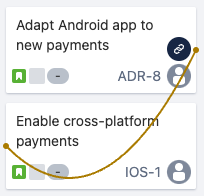Dependency lines on the User story map are only available:
-
on Jira Cloud (i.e. Jira sites with “….atlassian.net” in the URL)
-
on Jira Data Center with app version 13.0.0+; a Jira Administrator can install the latest version of the app .
When making plans, it’s important to manage the dependencies between different pieces of work. This allows you see and remove blockers so that your team can execute smoothly.
On the User Story Map, you can visualize links between Jira issues as dependency lines:

Dependency lines on the User story map are based on issue links in Jira:

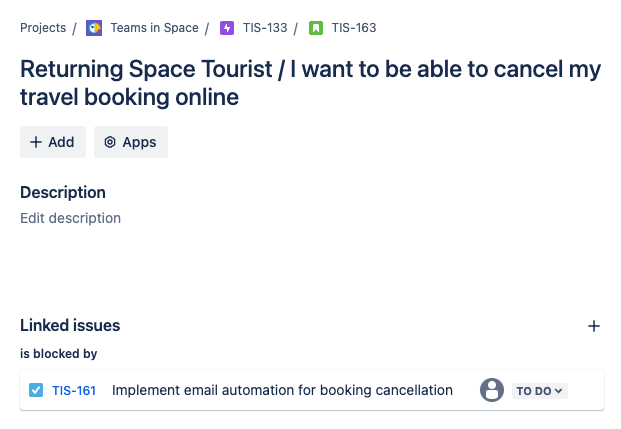
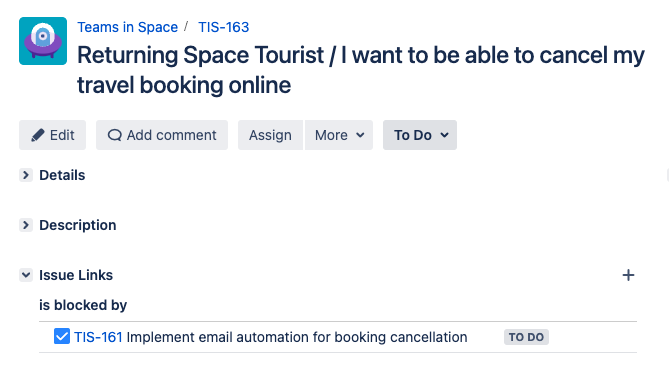
The app will show dependencies on standard-level issues, including Stories, Tasks and Bugs. Dependencies with sub-tasks and Epics aren’t currently displayed.
Dependency links will only show where:
-
Both of the linked issues are on the User Story Map; or
-
An issue on the User Story Map is linked to an issue outside this Jira board.
Why track dependencies?
Dependencies can turn into blockers and bottlenecks that disrupt the team’s flow. By spotting and addressing them early, you can respond to problems and keep going.
Too many dependencies can also indicate a problem with how work is broken down. Easy Agile recommends the “INVEST” strategy to craft user stories which are independent.
Another way of tracking risks and potential blockers is using Flags in Jira and the User story map .
Switching on dependency lines
Open the “Dependencies” dropdown in the User Story Map header to switch on dependency lines.
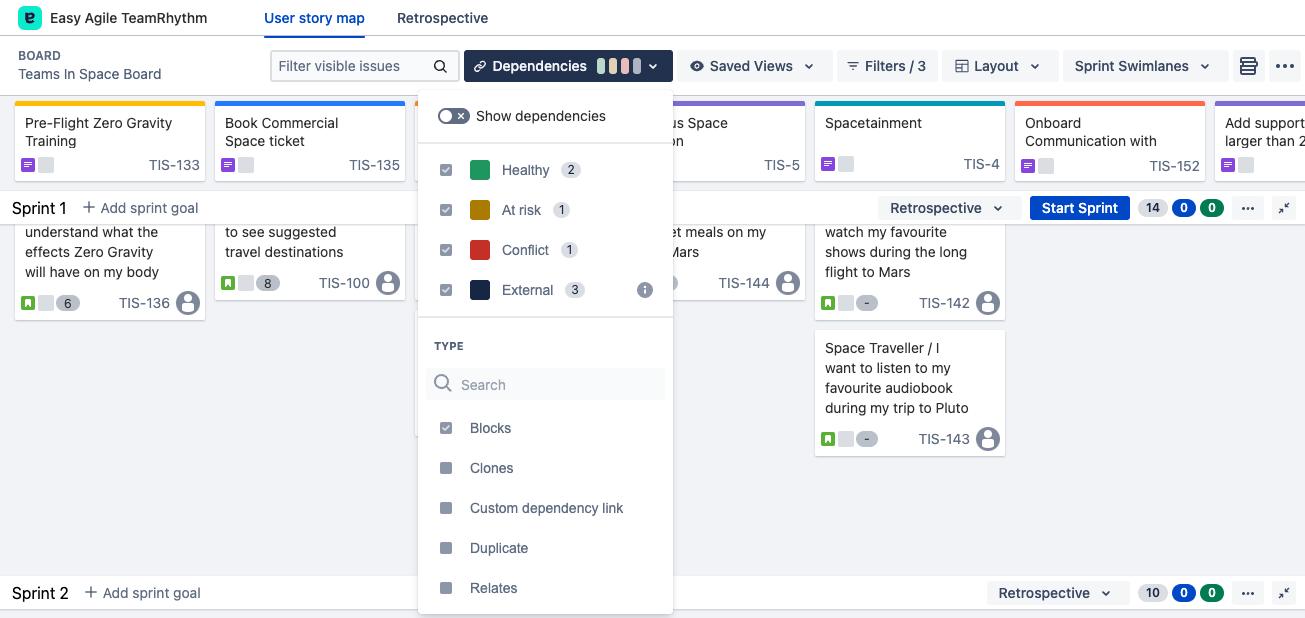
This is toggled off by default, but will remember how you last set it. All the configuration selected in this dropdown will be saved for you, and won’t affect the view for other users' or the User Story Map on other Jira boards.
Select issue link types from Jira
Select which link types you’d like to display as dependency lines.
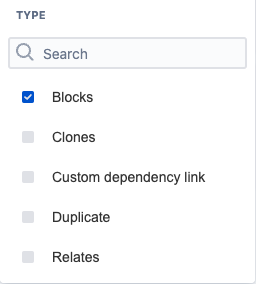
This list will show the link types available in Jira, which will include:
-
Default link types like “Blocks (blocked / is blocked by)”
-
Any custom link types added to your Jira site
A Jira Administrator can configure what link types are available in your Jira site. Learn more in Atlassian’s guide Configure issue linking for Jira Cloud or for Jira Data Center
Color-coded dependency health
A dependency line shows which issue needs to be done first, and which issue is dependent on it and must be done second.
-
A red line is shown when the second issue is scheduled before the first issue: this plan has a Conflict.
-
An yellow line is shown when both issues are scheduled in the same sprint: this plan is At risk.
-
A green line is shown when the issues are scheduled in the right sequence: this plan is Healthy.
-
A gray lozenge shows an external dependency with an issue: the issue linked to this one isn’t on this Jira board, so Easy Agile TeamRhythm can’t calculate the health. Read more about external dependencies below.
You can switch dependency lines on and off based on health. For example, you might switch off Healthy dependencies so you can focus on resolving the At-risk and Conflict plans.
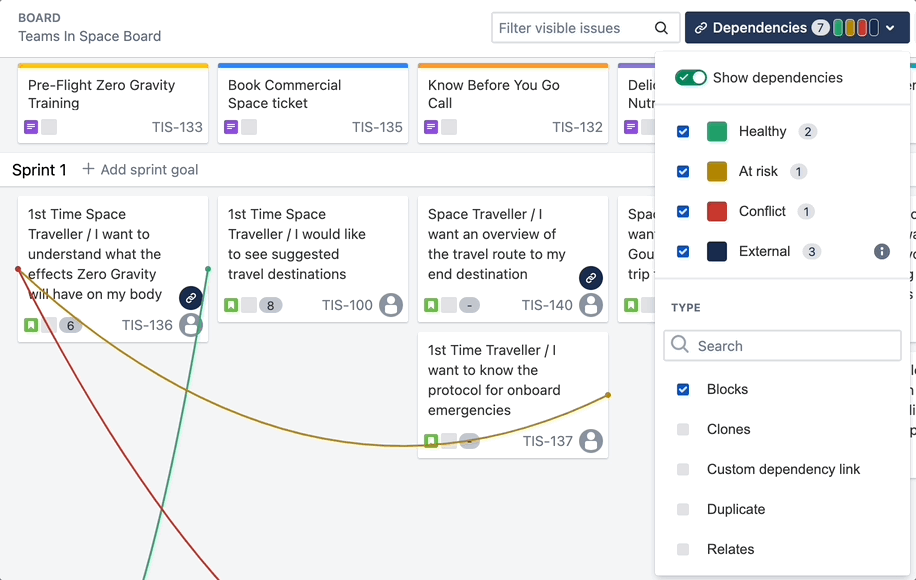
The Dependencies button in the app header shows:
-
What dependency health colors are currently switched on.
-
The total number of dependencies to display with the current settings.
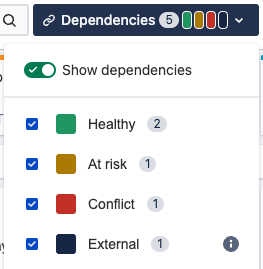
What is an external dependency?
An external dependency icon will show when an issue is linked to another issue outside this Jira board.
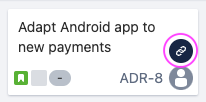
Easy Agile TeamRhythm uses the Jira board filter query to check if both issues should be in this board.
Learn more about how the Jira board affects the User Story Map here .
You won’t see an external dependency icon if you don’t have permission to view the other Jira issue.
Dependency details
When you hover over a dependency line, you’ll see an ![]()
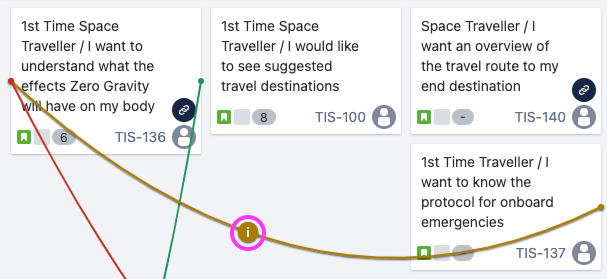
This will show the key, summary, type status, sprint, sprint dates, and project of each issue where available.
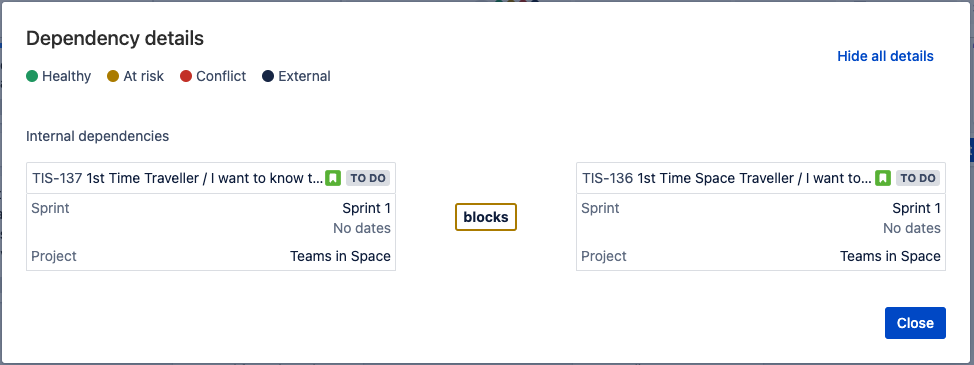
Clicking on the External dependencies icon will show details for all external dependencies for that issue.

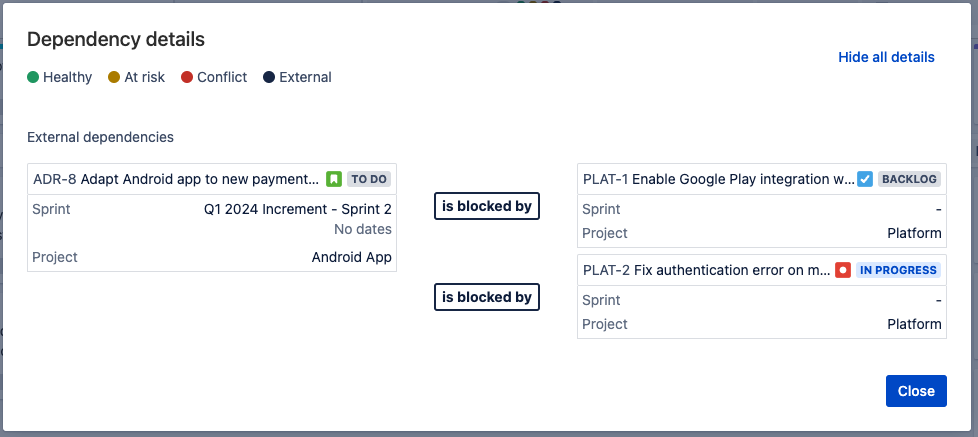
View all dependencies for an issue
Use the right-click or “…” button on an issue card and select “View dependencies” to see all dependencies for an issue at once.
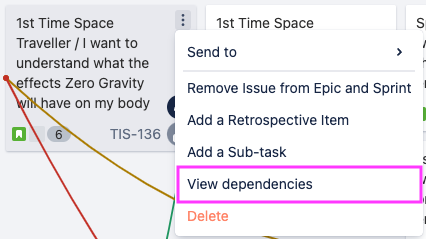
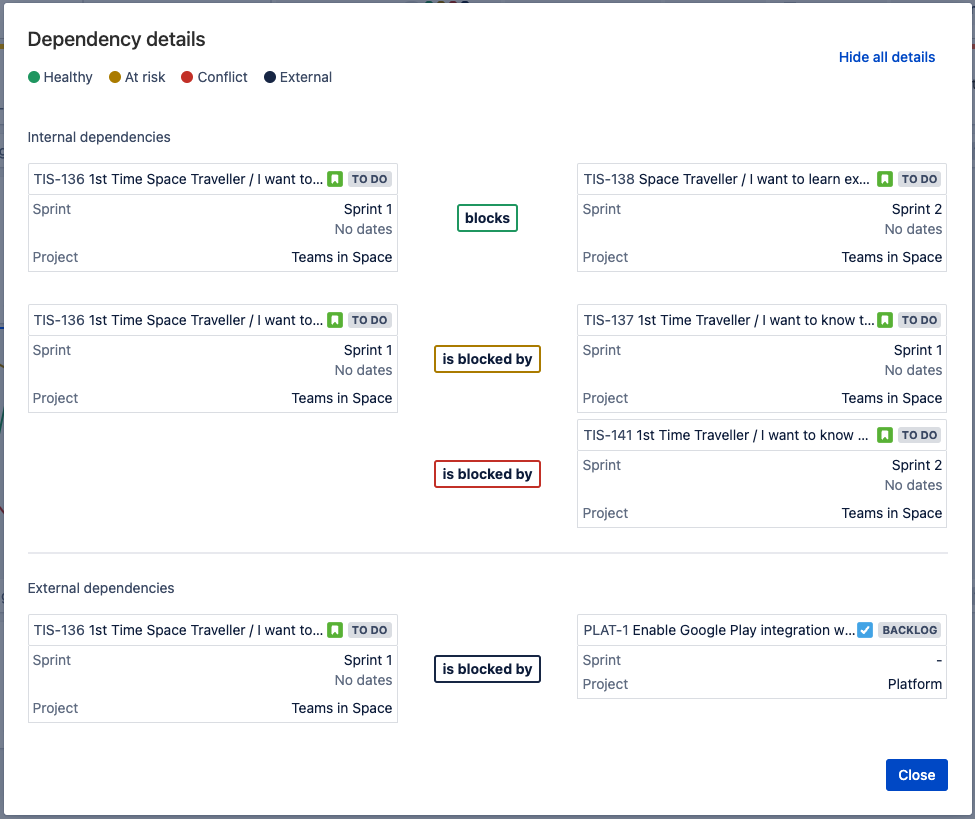
Creating and editing dependencies
The User Story Map will show dependency lines based on existing issue links.
To create new issue links or edit existing links, you’ll need to edit the issue in Jira.
|
Jira Cloud (has “….atlassian.net” in the URL) |
Jira Data Center |
|---|---|
|
Add new links with the 🔗 “Link issue” button: 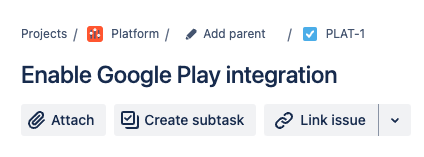
This might be shortened to just the 🔗 Link icon on small screens: 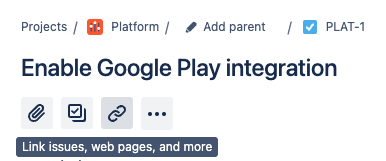
|
Add new links by opening the “More” menu and using the “Link” option: 
|
|
If you have existing issue links, you can see, edit and add them in the “Linked issues” section: 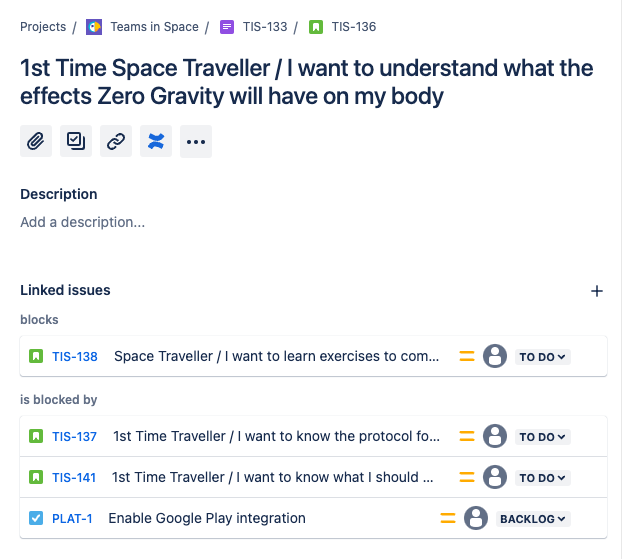
|
If you have existing issue links, you can see, edit and add them in the “Issue Links” section: 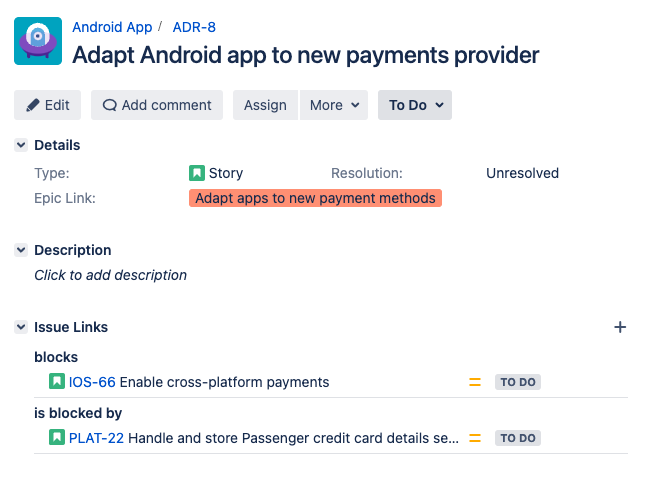
|
Can’t see dependencies?
If you can view and create issue links in Jira, but they’re missing on the User Story Map:
-
Check if you’re Jira Cloud, or Jira Data Center.
-
On Jira Cloud, the page URL will always have “.atlassian.net”. Dependency visualization is available on the User story map on all Jira Cloud sites.
-
If you’re on Jira Data Center and the Dependencies dropdown is missing from the app header, you’re likely on an earlier version of the app. Update the app, or ask a Jira Administrator to update it.
-
-
Check what filters are switched on in the Dependencies dropdown.
-
Try switching on all Health types (Healthy, At risk, Conflict).
-
Check that the link type named on the Jira issue is checked in the “Types”.
-
-
Check if both of the issues are currently visible on the User Story Map.
-
Check if an in-app filter is hiding some issues.
-
Check your swimlane mode in case the issue is in a “historical” sprint or version swimlane.
-
Sprint swimlanes mode hides issues which are (only) in Completed Sprints.
-
Versions swimlanes mode hides swimlanes in Released Versions .
-
-
-
If you expect to see an external dependency icon on an issue, check that the other issue is not on this Jira board. If it does meet the filter query for this board, it won’t show as an external dependency. You’ll need to make sure both issues are visible on the User Story Map so a dependency line displays.
-
If the issue is failing to show an external dependency icon (ie. about another issue outside this Jira board), AND the other issue is in a different Jira project, the app might be blocked from that other project. A Jira Administrator can block app access to projects using Data Security Policy .
If you can’t see or create issue links in Jira, contact your Jira Administrator or internal IT support team.
-
A Jira Administrator can enable or disable issue linking for the whole Jira site. See Atlassian’s guide for Jira Cloud or for Jira Data Center .
-
The “Linked issues” field might be hidden on the Issue Screen . This doesn’t stop the “Linked issues” section showing in the Jira issue view, but does prevent apps like Easy Agile TeamRhythm from loading issue link data.
-
To create new issue links, you’ll need the “Link Issues” permission. If the issues you want to link are from different Jira projects, you’ll need this permission for both projects. For company-managed Jira projects, this is configured in the Permissions Scheme selected for that project. A Jira Administrator can update these permissions.
If dependency lines still aren’t working for you, reach out to the Easy Agile support team !
